Helichrysum retortum
Helichrysum retortum (L.) Willd
Family: Asteraceae
Common names: coast strawflower, flask everlasting (Eng.); kus-sewejaartjie, strooiblom (Afr.)
Introduction
Pretty and tough, this low-growing groundcover with its silvery leaves and shiny white strawflowers is perfectly suited for containers, rockeries or coastal gardens where its showy leaves will be a perennial colour mainstay throughout the year.
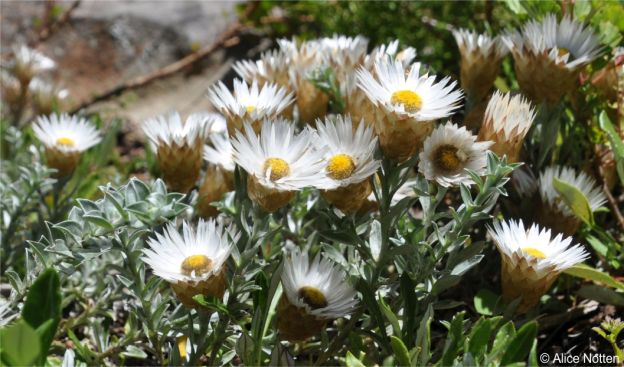
Description
Description
Low-growing spreading shrublet between 300-500 mm tall. The small silver-grey leaves are oblong, recurved and hooked at the tips. Dense silvery-silky hairs cover the surface of the leaves. Daisy-like everlasting flowerheads appear solitary on a single stem. There are no ray florets present, only yellow disc florets that form the yellow centre that is surrounded by papery bracts. Inner bracts are a shiny white. The outer bracts vary from pink to brown. Flowering is in spring and early summer, from August or September to December.
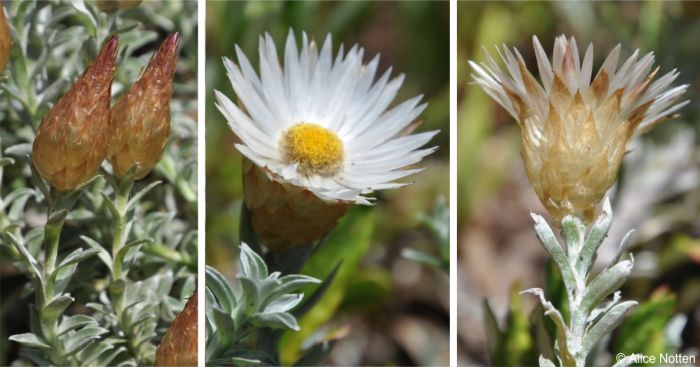
Conservation Status
Status
Despite some of this species’ habitat being encroached upon by coastal developments, it is not currently threatened. Populations are stable and not in decline. Any reduction in population numbers is expected to not exceed more than 30 % for the next three generations. The coast strawflower thus has a conservation status of Least Concern (LC) according to the Red List of South African Plants.
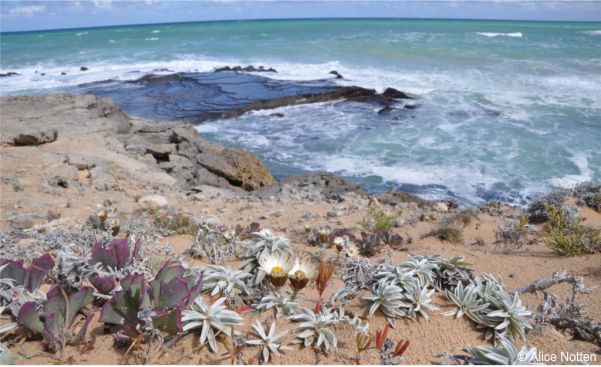
Distribution and habitat
Distribution description
The natural habitat of this species is cliffs above the seashore, coastal dunes and sandy flats and slopes close to the sea, from Bloubergstrand to Still Bay, in the Western Cape.
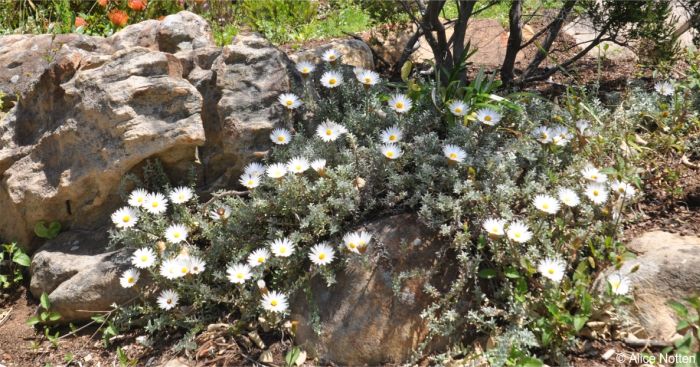
Derivation of name and historical aspects
History
The genus name Helichrysum, is derived from the Greek words helios, which means sun, and chrysos, gold, which is in reference to the yellow flowerheads of several species in this genus. The specific ephithet retortum is Latin for twisted or bent back; referring to the way the tip of the leaf is bent backwards.
Helichrysum retortum is a species within the Asteraceae or daisy family. The genus Helichrysum consists of about 500 species, which are found mainly in Africa. About half of all Helichrysum species, 240, can be found in southern Africa.
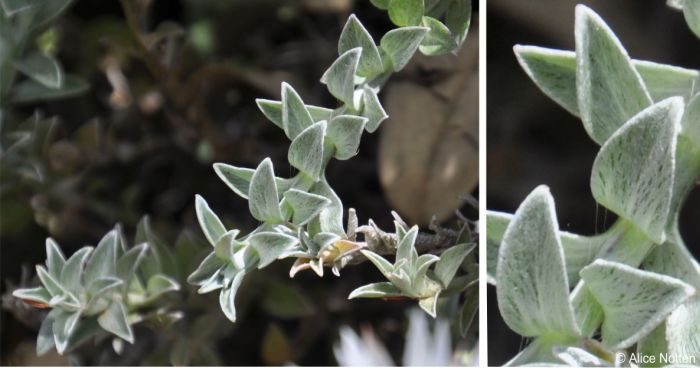
Ecology
Ecology
The silver-grey colour, hairy covering and small, narrow size of the leaves are all adaptations to aid the plant in reducing water loss. This colour reflects the sunlight, while the fine hairs and small leaf surface reduce transpiration.
Helicrysum retortum fruits are wind-dispersed. Not much is known about its pollination.
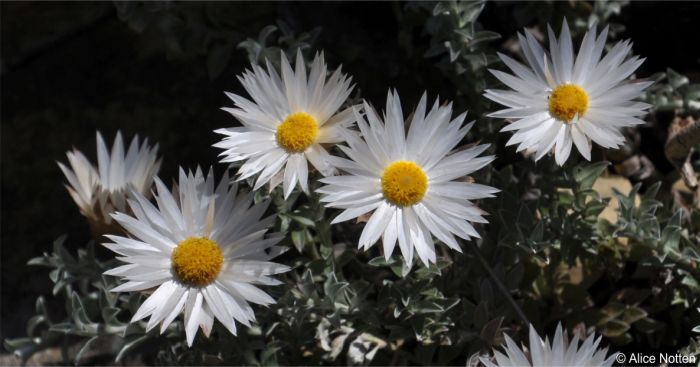
Uses
Use
Helichrysum species are well-known for their use as medicine, food and ornamental plants. Some species are also widely used in traditional medicine or in the past as bedding to repel insects. For H. retortum there are no cultural, medicinal or food uses recorded to date, but the species is a most delightful ornamental addition to a garden, pot or rockery. Here its silvery grey leaves will make for an excellent border plant as it contrast with other coloured-leaves or medium to broad-textured leaves.
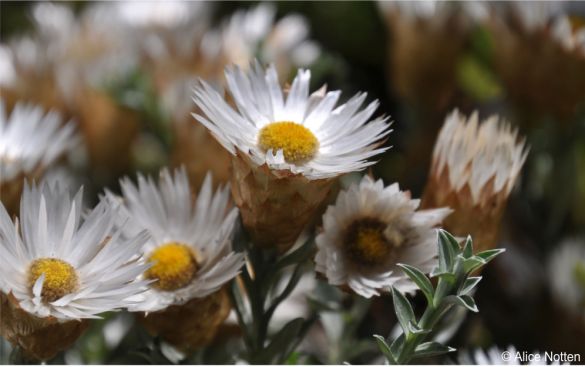
Growing Helichrysum retortum
Grow
Helichrysum retortum can be propagated vegetatively by stem cuttings from slightly stiff new growth. A rooting hormone suitable for semi-hardwood cuttings can be used to enhance the formation of roots. Cuttings are placed in a well-drained propagation medium, such as river sand, vermiculite or fine-milled bark. Place cuttings in a propagation house with adequate misting, lighting, good airflow, humidity and bottom heating. Monitor cuttings on a regular basis to ensure they receive sufficient water. Pot-on into a well-draining potting-mixture.
The author has not grown the species from seed before. However, since this is a fynbos species, an attempt at having the seeds to germinate can potentially involve exposing the seeds to a smoke pre-germination treatment. Not all Asteraceae species needs smoke to enhance their dormancy, so therefore no extra pre-treatment of the seed might even be required. Sow seeds in autumn using a well-drained potting medium. Germinated seedlings must be regularly monitored until big enough to be transplanted into a containers of suitable size.
This is a quick-growing, relatively water-wise plant that can be enhanced with some pruning when necessary. It is a good groundcover or filler in the garden in coastal areas, especially close to the shore-line, and in inland areas. This species should thrive in pots, balconies and rockeries.
A low-growing perennial, this species could be used along edges with equal impact in formal or informal planting. In its natural habitat it grows and thrives with a variety of species listed below as companion plants: Leucospermum prostratum, L. heterophyllum, Coleonema album, C. pulchellum, Agathosma capensis, A. gonaquensis, A. imbricata, A. dielsiana, A. hookerii, A. muirii, A. ciliaris, A. ovata, Acmadenia heterophylla, Cotyledon orbiculata, Salvia lanceolata, S. aurea, S. africana, Pelargonium betulinum, P. capitatum, P. fulgidum, P. fruticosum, P. gibbosum, P. cucculatum, Elegia tectorum, Restio festuciformis, Orphium frutescens, Othonna dentata, Senecio maritimus, S. elegans, S. arenarius, Aloe succotrina and Erica brachialis.
No pests have been observed.
References
- Bean, A. & Johns, A. 2005. Stellenbosch to Hermanus. South African Wild Flower Guide 5. Botanical Society of South Africa, Cape Town.
- Bohnen, P. 1986. Flowering plants of the southern Cape. The Sill Bay Trust, Still Bay.
- Foden, W. & Potter, L. 2009. Helichrysum retortum (L.) Willd. National Assessment: Red List of South African Plants version 2024.1. https://redlist.sanbi.org/species.php?species=3240-343.
- Manning, J. & Goldblatt, P. 2012. Plants of the Greater Cape Floristic Region 1: the Core Cape Flora. Strelitzia 29. South African National Biodiversity Institute, Pretoria.
- May, Z. & Notten, A. 2019. Helichrysum patulum (L.) D.Don (Asteraceae). PlantZAfrica. Online. http://pza.sanbi.org/helichrysum-patulum.
- Parker, T. 2025-7. Edmondia sesamoides. (L.) Hilliard. (Asteraceae). PlantZAfrica. Online. https://pza.sanbi.org/edmondia-sesamoides.
- Swelankomo, N. 2004-12. Helichrysum-odoratissimum (L.) Sweet. (Asteraceae). PlantZAfrica. Online. https://pza.sanbi.org/helichrysum-odoratissimum.
- Trinder-Smith, T.H. 2003. The Levyns Guide to the plant genera of the south western Cape. Bolus Herbarium, UCT, Red Roof Design CC, Cape Town
- Van der Walt, L. 2003-12. Helichrysum splendidum. (Thunb.) Less. (Asteraceae). PlantZAfrica. Online. https://pza.sanbi.org/helichrysum-splendidum.
- Vlok, J. & Schutte-Vlok, A-L. 2015. Plants of the Klein Karoo. Umdaus Press, Hatfield.
- Zenze, K. 2012-7. Helichrysum cymosum. (L.) D.Don. (Asteraceae). PlantZAfrica. Online. https://pza.sanbi.org/helichrysum-cymosum-subsp-cymosum.
Credits
Roger Oliver
Kirstenbosch National Botanical Garden
December 2025
Acknowledgements: images by Alice Notten
Plant Attributes:
Plant Type: Ground Cover, Shrub
SA Distribution: Western Cape
Soil type: Sandy
Flowering season: Spring, Early Summer
PH: Acid, Alkaline, Neutral
Flower colour: Brown, White, Yellow
Aspect: Full Sun
Gardening skill: Easy
Special Features:
Horticultural zones
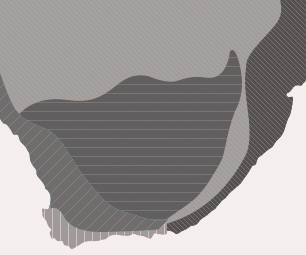







Rate this article
Article well written and informative
Rate this plant
Is this an interesting plant?
Login to add your Comment
Back to topNot registered yet? Click here to register.